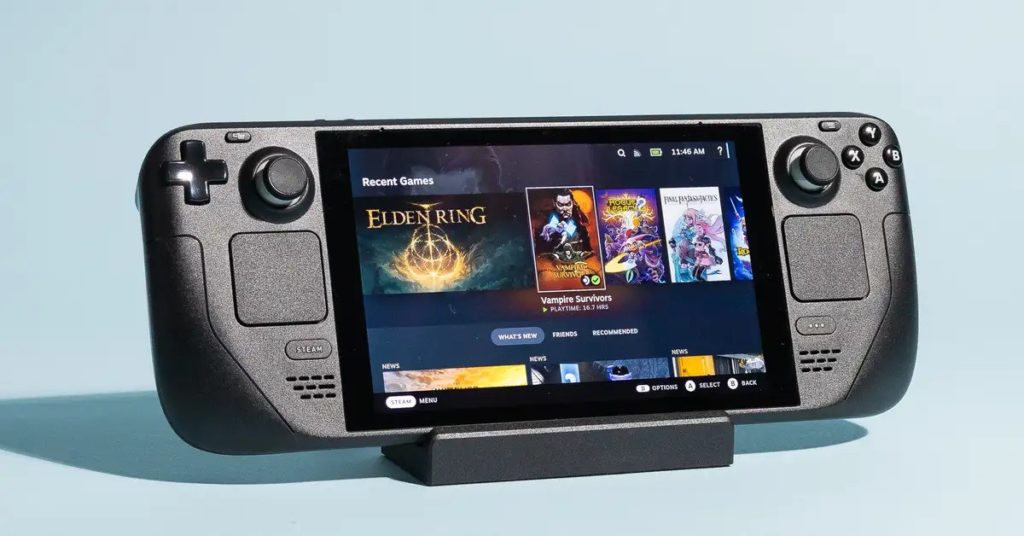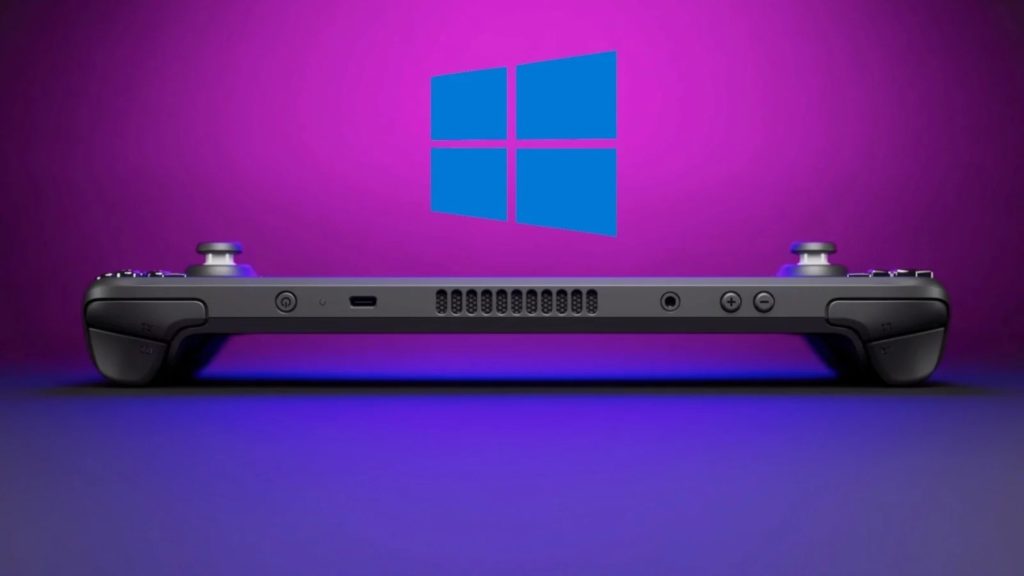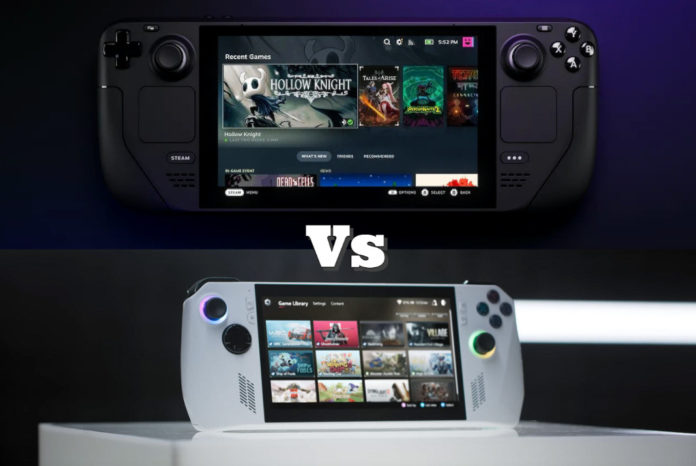You may have heard it before, but 2023 surely looks set to be the year gaming handhelds finally make their long-awaited mainstream comeback. Ever since the failure of the PlayStation Vita during the early years of the iOS/Android gaming boom, the focus of PC and console gaming has largely shifted towards bigger screens (except for Nintendo of course, who have always done their own thing anyway). However, the smash success of the Steam Deck, Valve’s hybrid handheld console/gaming PC, has proven that there is a desire in the mainstream market for more portable high-end gaming experiences once more, even if there are some small trade-offs in the process.
Make no mistake about it – the Steam Deck is a smashing success. According to a new Omdia report, Valve’s new handheld is projected to cross over 3 million in sales by the end of 2023. Considering the widespread production issues faced by Valve, the lack of any official retail presence, and a limited launch exclusive to the United States, Canada, the European Union, & the UK so far, such sales figures are well beyond initial expectations. With reservations now open in Japan, South Korea, Taiwan, & Hong Kong, and further releases expected soon, we could well see the Steam Deck capture a sizable segment of the handheld gaming market in the next year or two.
On the heels of Steam Deck’s success, several new players are looking to stake their claim in what is now a burgeoning gaming handheld PC market. Some, like Ayaneo and GPD, are experienced operators within this niche, while others like Asus have only just thrown their hats in the ring. There are even rumors of an all-new PlayStation handheld in the pipeline. However, can any of the upcoming new handhelds truly compete with the literal and metaphorical behemoth that is the Steam Deck? Read on to find out:
More is Not Always Better
In general, the strategy being adopted by prospective competitors of the Steam Deck is one focused on offering superior hardware – more processing power, more screen resolution, higher refresh rates, etc. From a pure hardware perspective, the Asus ROG Ally looks to be a Steam Deck on steroids. It has an upgraded processor, a sharper and brighter 1080p screen that runs at 120 Hz, and better thermal performance and noise levels, all in a more compact form factor than the Steam Deck. The PC gamer in me is profoundly impressed by how much power and functionality Asus has managed to cram into such a portable device.
However, for the purposes of a handheld gaming device, many of the headline features of the ROG Ally may actually be detrimental to the overall handheld gaming experience. The faster processor also consumes a lot more power – up to 35W under full load compared to 15W on the Steam Deck. The significantly greater power draw is a concern since it means that the ROG Ally could have worse battery life than the Steam Deck even, which can run out of battery in under 90 minutes while playing newer AAA games.
Even further exacerbating the battery problem is the brighter screen, pushing 2x as many pixels as the Steam Deck at twice the refresh rate. Running at full pelt, the ROG Ally is unlikely to last long enough on battery for any sort of extended gaming session. Furthermore, if you intend to play games on the ROG Ally at native 1080p, framerate performance is likely to be very similar to or even worse than the Steam Deck despite the faster processor, since it now has to push double the resolution, making the 120Hz refresh rate redundant in anything but the most basic indie titles.
The Software Ecosystem

Quite possibly the single biggest hurdle for any potential Steam Deck competitor is the prospect of rivaling the seamless software and user experience offered by SteamOS on Valve’s handheld. SteamOS is a custom gaming operating system that is built for purpose but also offers an unprecedented level of user customization and developer friendliness. The Steam Deck has only been around for a year but the team at Valve has been hard at work, rolling out updates regularly and working with the community to iron out bugs and compatibility issues while adding a plethora of new features that simply were not available at launch. This has immensely improved the value proposition and bodes well for the future of the device, as it signals Valve’s intent to support the Steam Deck as a long-term platform.
However, the real secret sauce of SteamOS lies in its open source nature, and a growing community that has taken full advantage of it. Over the past year, we have seen the features and capabilities of the Steam Deck expand at a startling rate, thanks in so small part due to the diligent work of the passionate user community that has developed along with the device. You can get any number of plugins to personalize your Steam Deck experience and emulation is easy as a breeze, potentially expanding the Steam Deck’s already massive library of games to almost anything you could think of, past and present.
Competitors like the Ayaneo 2, GPD Win 4, and even the upcoming ROG Ally typically run on a version of Windows, with some sort of in-house overlay software provided by the manufacturer. While Windows remains the gold standard for desktop-based PC gaming, it is inherently a general-purpose operating system designed with a desktop/laptop environment in mind. This presents several problems for any Windows-powered gaming handheld, one of which is the fact that Windows is optimized for mouse and keyboard input, and doesn’t work particularly well with traditional video game inputs such as joysticks and triggers. Some of these issues can be ameliorated by the manufacturer’s in-house software but even so, the general user experience is rather clunky and definitely far from ideal. Valve gets around these issues on their handheld with some help from the simplified custom user interface, as well as additional hardware inputs such as the dual trackpads and rear buttons.
Additionally, Windows does a poor job of emulating certain crucial handheld features such as Sleep mode, which might not be particularly important for desktop PC gaming but is vital for gaming on the go. The general purpose nature of the OS also means that Windows is weighed down by a lot of feature bloat and background processes that have no practical functionality on a handheld gaming device. All in all, while a power user might certainly be able to extract a lot more from a more powerful Windows-powered handheld device, it will also entail a level of jankiness and tinkering that might be beyond the comfort zone of most users who simply want to play games on their porch or the bus.
The way most handheld manufacturers are going about trying to address these user experience issues is via their in-house software overlays. For example, Asus has announced that the ROG Ally will come with a custom software interface called Armoury Crate for accessing game/hardware settings and customization options. If the name Armoury Crate sounds familiar to you, that’s because Asus already publishes famously buggy motherboard software under the same name – it’s certainly not a track record that inspires great confidence. And since Asus is primarily a hardware-first company, long-term updates and support for Armoury Crate could be scarce.
Value Proposition and Longevity
Perhaps the most unique quality of the Steam Deck is how it straddles the line between console and PC so expertly. The general framework of the Steam Deck ecosystem is very reminiscent of consoles – it is powered by a gaming-centric operating system, prominently features a first-party storefront, and provides an impressive value proposition due to the manufacturer subsidizing the hardware cost. However, Valve managed to do all this while keeping SteamOS open source, allowing users to customize and modify their devices to their heart’s content. In a recent interview with Edge Magazine, Valve CEO Gabe Newell confirmed that the company views the Deck as a “permanent addition” to the PC space. In yet another interview with Rock Paper Shotgun, Valve designer Lawrence Yang confirmed that any potential Steam Deck 2 is still years away.
What all of this means is that the Steam Deck is likely to enjoy a typical console life cycle of up to 4-5 years. There are numerous benefits that come with a typical console life cycle, the biggest one being that it allows the device to accumulate a larger install base. This makes the prospect of years of consistent support from Valve as well as the growing user community a very realistic expectation, continuing to evolve and refine the Steam Deck experience even as the hardware gets older. In barely a year’s time, we have already seen game-changing new features being added to the Steam Deck including 40-60Hz display support, VRS, and per-game performance profiles. Another benefit of having a large install base and console length lifecycle is that it provides a stable performance target for game developers to keep in mind while developing their own games. This can mean that gamers may be able to play the latest AAA games on their Steam Deck for years to come. The Nintendo Switch, which runs on 6-year-old hardware that was considered underpowered when it first launched, is still going strong all these years later since developers can design their games around the hardware.
On the surface , the ROG Ally looks like a very similar product to the Steam Deck. However, the two devices exist within the context of two very different business models. As a software-first company, Valve is able to subsidize the cost of the Steam Deck and make its money back by selling games on its first-party Steam storefront. The Steam Deck essentially operates as the company’s “loss leader” product, intended to grab eyeballs and users and funnel them toward the Steam storefront. This is why Valve was able to bring down the price of the base Steam Deck to $399, which is an extremely high-value proposition for such a capable device. In contrast, companies like Asus, Ayaneo, GPD, etc. are primarily hardware companies. Asus generates the lion’s share of its revenue from the margins on hardware sales, and the ROG Ally will be no different. Since Asus lacks any first-party storefront or software service to generate revenue, it has to rely on a significantly higher sticker price for the device itself; one thing is for certain – the ROG Ally will certainly offer less value for money compared to the Steam Deck.
More importantly, since hardware-first manufacturers only make more money by selling more units, the company is incentivized to release a new and upgraded model every 12-18 months, in line with most desktop PC hardware launches. Such a short product lifecycle is well suited for the cutting-edge PC gaming space, but will significantly harm the long-term prospects of any potential gaming handheld as it makes it impossible for the device to garner a large enough install base and a veritable library of user-generated content. Without a sufficient install base, most game developers may not even bother optimizing their games with the ROG Ally in mind a couple of years down the line, especially considering we may get an ROG Ally 2 or Ally 3 by then. Considering all of these myriad factors, it is much more likely that the ROG Ally will compete with the likes of the Ayaneo 2 and the GPD Win 4 rather than the Steam Deck.
Who Can Compete?

Having explored why shiny new gaming handhelds like the ROG Ally fundamentally cannot compete with the Steam Deck, naturally, the next question that comes to mind is – who can compete? Companies like Asus have the hardware expertise to create a viable competitor but lack the software infrastructure and user base to pose any kind of long-term threat to Valve. Realistically speaking, the two companies with the best chance at dethroning the Steam Deck are the two industry giants of gaming – Sony and Microsoft. Both companies boast a long history of producing top-tier gaming hardware as well as a robust software ecosystem and e-commerce storefront to support it.
Sony, in particular, has an illustrious pedigree when it comes to handheld gaming, but the company has shied away from the market ever since the failure of the PS Vita. This may be about to change soon with all the rumors floating about a new PlayStation handheld currently in development. However, the rumors also indicate that the new PlayStation device could be a dedicated Remote Play device designed to work in conjunction with a full-fledged PlayStation 5. While there is certainly a market for such a device, it is not the same one as the one for the Steam Deck.
On another end of the spectrum, Microsoft certainly has the know-how and software infrastructure in place to potentially thrive in the increasingly competitive handheld market. Xbox Game Pass is an immensely popular games subscription service on both PC and Xbox, and a hypothetical Xbox handheld powered by Game Pass could offer an unbeatable value proposition that rivals the Steam Deck. And while Windows OS in its current state is not ideal for handheld gaming, Microsoft is certainly capable of developing a gaming-centric offshoot of Windows that gets rid of unnecessary features while still maintaining the compatibility and integration benefits of gaming on a Windows-based OS. In fact, The Verge reports that Microsoft may already be exploring the possibility of building a dedicated handheld mode for Windows to better support devices like the Steam Deck. Currently there is no concrete indication of Microsoft’s desire to compete directly in the handheld market. However, the handheld gaming console industry continues to grow at a rapid rate and is expected to reach nearly $25.65 billion in size by 2029. If we continue seeing such reliable growth, I wouldn’t be surprised if Microsoft changed its mind about dipping a toe in the gaming handheld market in the near future.



This misses the forest for the trees. The author either has an agenda or did not do the required research.
Everything is correct, but omits any further information that could contradict the overall message that is being crafted.
Just for example, the ally can run in the same tdp, resolution, and refresh rate as the deck, but has a bigger battery. So yes, if you crank everything up you will have a higher fidelity experience but less battery life. However it is very easy to set the ally to similar settings to what the deck uses and then you would have the same experience fidelity wise, but much longer battery life.
You can do better.
Hi Rory,
Thanks for reading the article! I always appreciate feedback.
As to your point, while it is true that you could set the Ally’s resolution to Steam Deck equivalent settings and enjoy better performance, the problem is that the Ally has a native 1080p display, whereas the Steam Deck is native 800p. Due to the nature of how pixel scaling works, an 800p output on a native 800p screen looks significantly better than on a native 1080p screen.
According to Engadget’s breakdown, the battery in the ROG Ally is 40Wh, roughly similar to Steam Deck. This means that realistically speaking, trying to use the ROG Ally at maximum settings will lead to better visuals but very poor battery life, and turning down the resolution settings will result in noticeably worse image quality compared to the Steam Deck.